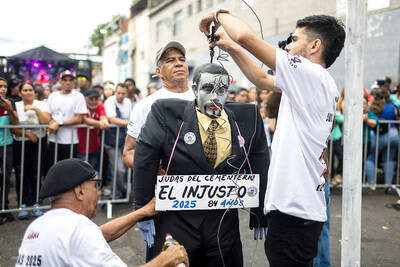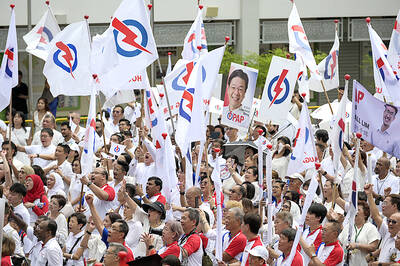Construction workers from Bangladesh, hotel staff from the Philippines, waitresses from China, shipyard welders from Myanmar, technology professionals from India — Singapore has them all.
For years the rich but worker-starved city-state, built by mainly Chinese immigrants, had rolled out the welcome mat for foreigners, whose numbers rose drastically during the economic boom from 2004 to 2007.
However, with one in three of the 5 million people living on the tiny island now a foreigner and citizens complaining about competition for jobs, housing and medical care, the government is taking a fresh look at its open-door policy. With the grumbling getting louder and general elections expected to be called before they are due in 2012, the government has unveiled measures to reduce reliance on foreigners and assure citizens they remain the priority.
“There are social and physical limits to how many more we can absorb,” Singaporean Finance Minister Tharman Shanmugaratnam told parliament last month.
He said the government will make it costlier for companies to hire foreigners by raising the levies they must pay for every non-Singaporean or non-resident they hire.
The government also earmarked S$5.5 billion (US$3.9 billion) over the next five years to upgrade Singaporean workers’ skills to boost their productivity, make them more competitive and raise incomes.
It imposed measures to cool down rising home prices, also blamed on foreigners buying into the property market, and pledged it will further tighten the process of accepting permanent residents and new citizens.
Of Singapore’s population of nearly 5 million last year, 533,200 were permanent residents and 1.25 million were foreigners on employment passes, along with their families, official statistics show.
“I think it is shaping up to be one of the hottest issues in Singapore today,” political commentator Seah Chiang Nee said.
Economist Song Seng Wun of CIMB-GK Research said that apart from helping local companies rise up the value chain, the new measures will also address potential election issues.
Singapore’s last elections, held in 2006, saw the People’s Action Party returned to power for six years, continuing its uninterrupted rule over the island since 1959.
“The government has to be seen doing something in areas that are potential flashpoints,” Song said.
Disenchantment over foreign workers gained momentum during a severe economic slump that began in the third quarter of 2008, when trade-reliant Singapore became the first Asian economy to slip into recession.
Drastic job and salary cuts were implemented, affecting many white-collar workers.
In coffee shops, Internet forums, letters to newspapers and sessions with members of parliament, citizens became more vocal about the rapidly growing numbers of foreigners in their ranks.

POLITICAL PRISONERS VS DEPORTEES: Venezuela’s prosecutor’s office slammed the call by El Salvador’s leader, accusing him of crimes against humanity Salvadoran President Nayib Bukele on Sunday proposed carrying out a prisoner swap with Venezuela, suggesting he would exchange Venezuelan deportees from the US his government has kept imprisoned for what he called “political prisoners” in Venezuela. In a post on X, directed at Venezuelan President Nicolas Maduro, Bukele listed off a number of family members of high-level opposition figures in Venezuela, journalists and activists detained during the South American government’s electoral crackdown last year. “The only reason they are imprisoned is for having opposed you and your electoral fraud,” he wrote to Maduro. “However, I want to propose a humanitarian agreement that

ECONOMIC WORRIES: The ruling PAP faces voters amid concerns that the city-state faces the possibility of a recession and job losses amid Washington’s tariffs Singapore yesterday finalized contestants for its general election on Saturday next week, with the ruling People’s Action Party (PAP) fielding 32 new candidates in the biggest refresh of the party that has ruled the city-state since independence in 1965. The move follows a pledge by Singaporean Prime Minister Lawrence Wong (黃循財), who took office last year and assumed the PAP leadership, to “bring in new blood, new ideas and new energy” to steer the country of 6 million people. His latest shake-up beats that of predecessors Lee Hsien Loong (李顯龍) and Goh Chok Tong (吳作棟), who replaced 24 and 11 politicians respectively

Young women standing idly around a park in Tokyo’s west suggest that a giant statue of Godzilla is not the only attraction for a record number of foreign tourists. Their faces lit by the cold glow of their phones, the women lining Okubo Park are evidence that sex tourism has developed as a dark flipside to the bustling Kabukicho nightlife district. Increasing numbers of foreign men are flocking to the area after seeing videos on social media. One of the women said that the area near Kabukicho, where Godzilla rumbles and belches smoke atop a cinema, has become a “real

‘WATER WARFARE’: A Pakistani official called India’s suspension of a 65-year-old treaty on the sharing of waters from the Indus River ‘a cowardly, illegal move’ Pakistan yesterday canceled visas for Indian nationals, closed its airspace for all Indian-owned or operated airlines, and suspended all trade with India, including to and from any third country. The retaliatory measures follow India’s decision to suspend visas for Pakistani nationals in the aftermath of a deadly attack by shooters in Kashmir that killed 26 people, mostly tourists. The rare attack on civilians shocked and outraged India and prompted calls for action against their country’s archenemy, Pakistan. New Delhi did not publicly produce evidence connecting the attack to its neighbor, but said it had “cross-border” links to Pakistan. Pakistan denied any connection to